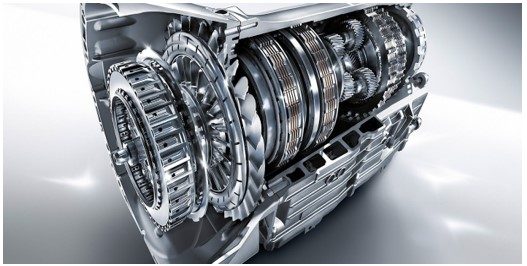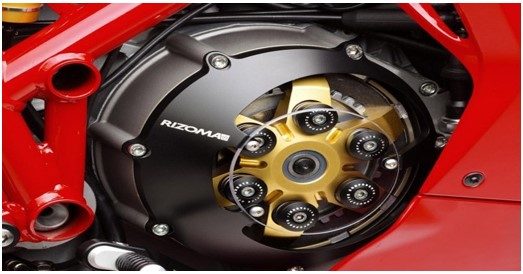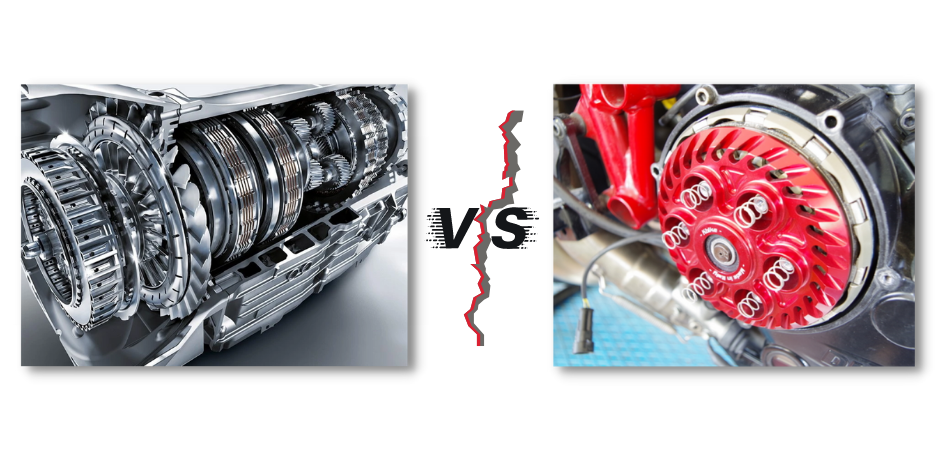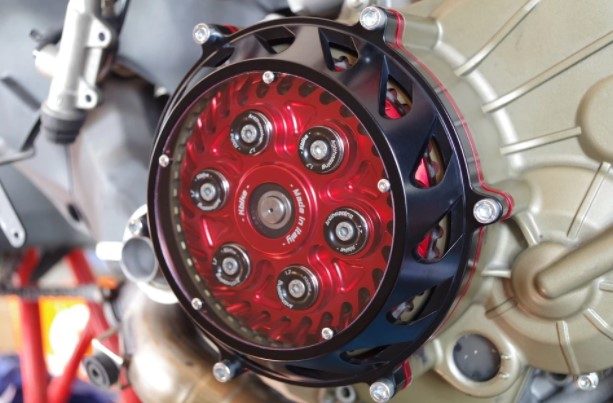What are the differences between a wet and a dry clutch? After all, whether you’re using a wet or a dry clutch, they’ll do the same function, right? First off, you should understand that they aren’t called their names because they’re wet or dry.
A wet clutch has sufficient oil lubricants, while a dry clutch has no lubricant. The presence of a lubricant on one makes it operate differently from the other. However, both the dry and wet clutch do the same work on your bike.
To learn more about wet clutch vs dry clutch, continue reading.
Wet Clutch Vs Dry Clutch: Quick Comparison Chart
| Description | Wet clutch | Dry clutch |
| Durability | Higher durability | Lower durability |
| Heat dissipation | Impressive | Bad |
| Torque transmission | Lower | Higher |
| Frictional coefficient | Lower coefficient of friction due to the presence of lubricant oil. | Higher coefficient of friction due to the absence of lubricant |
| Presence of lubricants | Yes | No |
| Clutch plate | Perforated | Not perforated |
| Cost and expenses | Low | High |
| Type of clutch plate | A multi-plate clutch is used | A single-plate clutch is used |
What Is A Wet Clutch & How Does It Work?
A wet clutch is called “wet” simply because it is soaked in engine oil. The engine oil, in this case, serves in two ways. It functions as a lubricant, thus reducing the friction between the clutch plates. Secondly, it helps in cooling the clutch plates.

The cooling effect of the oil on the clutch makes it possible for the wet clutch to withstand abuse than the dry clutch. Generally, wet clutches have an impressively wide zone of friction. As a result, they are pretty much easier to use when compared with dry clutches.
Also, a wet clutch operates almost noiselessly as it makes very minimal noise when engaged. These clutches work seamlessly and would give a motorcycle dummy an easy learning time. And just in case we forgot to include that, they last way longer.
What Are The Advantages OF Wet Clutch
1. Increased durability
The presence of the oil in a wet clutch keeps the system sufficiently lubricated. As a result, the system has a higher resistance to wear and tear caused by friction on rubbing parts. The oil bath also helps to shield the moving metallic parts from dust.
2. Presence of high torque
You always want to go for automobiles with higher torque ratings, right? Thanks to the large torque provided by the wet clutch. The multiple plates present in the wet clutch are the reason behind the high torque it has. The increased surface area created by the multiple plates increases the surface friction. High surface friction simply results in high torque and vice versa.
3. Quietness of operation
If you’re looking to make your car or bike move with the lowest possible noise, then there are things you need to fix or replace. The clutch present in your car also contributes to the amount of noise it generates. We recommend a wet clutch to help reduce the noise from your loud automobile.
4. Low temperature
The temperature of your wet clutch is regulated by the oil it contains. This means that wet clutches run at a comfortably low temperature.
5. Removal of dust particles
The presence of dust particles in your clutch can reduce the efficiency of its operation. The oil is useful in carrying the dust particles which are trapped in the oil filter.
What Are The Disadvantages Of Wet Clutch
1. Loss of power in the oil
The oil present in the clutch somewhat diverts some of the torque generated by the clutch. Wet clutch can also cause power loss due to the resistance it creates. This results in increased power consumption for less value.
2. Slipping clutches
The oil present in your clutch must have some properties for the plates to function properly. If the oil contained in your clutch has the wrong frictional properties can cause the clutch plates to slip.
3. Reduced power and efficiency
The presence of oil between the plates in your clutch reduces the efficiency of both the power and torque of the system. This is because of the drag your plates experience when they spin in oil. That fluid drag also makes use of power from your automobile engine.
4. Messier engine oil makes them difficult to work with
Not every automobile repairer out there feels very comfortable looking, all covered in grease. The oily clutch part does just that, making it more difficult to work with during a repair. Furthermore, the engine oil contained in vehicles that use wet clutches is very dirty. This results from metal dust collected over time.
What Is A Dry Clutch & How Does It Work?
A dry clutch is simply the direct reverse of the wet clutch – it contains no oil to bathe its plate. Furthermore, this type of clutch runs with friction and has its plate on the engine casing exterior. The plate’s exposure to the atmosphere helps to create the cooling that otherwise should have been done by the oil.

Furthermore, dry clutches have plates with larger sizes. The large plate size of the dry clutch creates a larger surface area, resulting in proper cooling of the plate. Otherwise, the plate will easily and quickly heat up.
However, dry clutches come with a very loud noise which many people consider a huge red flag. This noise gradually increases as your clutch keeps experiencing the wear and tear of its metallic parts.
What Are The Advantages Of Dry Clutch
1. Minimal power consumption
Since the clutch plate of your dry clutch doesn’t have to spin in oil, it conserves power. There’s also proper channelling of torque generated to the engine.
2. Less maintenance cost
You can easily fix defects in your dry clutch since its plate is located outside. Furthermore, you don’t need oil to keep your clutch running properly, reducing expenditure.
3. Reduced power transmission
All the power created in the engine is channelled in the right direction as there’s no oil to drain some of the power in the wrong direction. Furthermore, a dry clutch can handle more power than a wet clutch of the same size.
What Are The Disadvantages Of Dry Clutch
1. Very noisy
Dry clutches let off an unpleasant noise when the driver disengages the clutch. This is usually caused by the clutch plates bouncing against each other.
2. They can be hard to modulate
You might as well be ready for some trouble whenever you hammer your dry clutch. This is because there’s no oil to keep the parts sufficiently lubricated.
3. Easier wear and tear of parts
Dry clutches can be very difficult to keep at a moderate temperature, especially due to their dependence on external cooling. This makes it easier for the parts to degrade from wear and tear. Generally, dry clutches have very low durability when compared to wet clutches.
4. Relatively difficult take-off
Since the parts are not lubricated, dry clutches tend to grab when you engage. This can be ignored but can make it difficult to take off if it worsens. This grabbing effect further contributes to the quick wearing of your clutch.
Wet Clutch Vs Dry Clutch: What Are The Similarities And Differences?
We already mentioned that the main difference between the two different types of clutches is the presence of lubricant oil. However, it goes beyond just the presence of oil in the clutch plates, and there are also similar properties possessed by the two types.

Similarities Between Wet Clutch And Dry Clutch
There aren’t many similarities between the two kinds of clutches. Below are the few key similarities we were able to identify.
- Both types of clutches have plates present in them.
- Both clutches serve the same purpose – which is to transmit power from the driving shaft to the driven shaft of an automobile.
- The plates present in both clutches need to be cooled.
- They both possess a coefficient of friction.
Differences Between Wet Clutch And Dry Clutch
There are many distinguishing features when we do a wet clutch vs dry clutch matching. We’ll be considering the differences under some key factors.

Durability
Wet clutches have engine oil in their plates that help to keep them lubricated. This lubrication reduces the event of wear and tear. As a result, wet clutches have a higher life cycle when compared to dry clutches.
On the flip side, dry clutches are more prone to wear and tear of the parts since there’s no oil to keep the parts running smoothly. This results in your having to fix or replace the clutch more often.
Cooling
Wet clutches have their drive plates located inside the clutch cage or basket. The oil present in the clutch helps to drive these plates and, at the same time, keep them cool.
On the other hand, the driver plate of a dry clutch is located on the outside of the cage. This exposes it to the atmosphere to keep it cool. The plates on dry clutches are also perforated to allow air passage.
Noise Generated
Wet clutches operate almost noiselessly. Dry clutches, on the other hand, are very noisy. This is due to the plates constantly bouncing off each other. The noise generated from the dry clutch steadily increases as the parts wear.
Mode Of Operation
Wet clutches depend on the engine oil present in them for proper operation. Also, wet clutches work well in vehicle engines where the torque is high, as they are properly cooled to withstand the high temperatures such high torque engines generate.
On the other hand, dry clutches will only work well with car engines that have low torque. An engine with a very high torque will end up giving you issues if you’re using a dry torque.
Coefficient Of Friction
Wet clutches come with multiple plates. This results in a large surface area which further causes a high coefficient of friction.
On the other hand, Dry clutches have just one frictional surface doing all the power transmission between the plates. Because of this, dry clutches have a lower frictional coefficient.
Cost Of Maintenance
Wet clutches have a high cost of maintenance since they have several plates, resulting in more things to be repaired if the need arises. Also, dust particles collected in the oil will deposit on the filter and require cleaning.
On the other hand, Dry clutches have a single plate and fewer running parts, making the cost of repair higher.
Final Thoughts
The legendary sound of a Ducati is a great representation of what a dry clutch sounds like. This sound, however, is a huge turn-off for many people, while some people consider it interesting. If you’re looking to see the outcome in a wet clutch vs dry clutch match, then you just picked the right article.
In this article, I have taken the time to highlight the key differences and similarities between a wet clutch and a dry clutch. Also, you’ll find a detailed overview of both kinds of clutches. If you’re yet to decide what kind of clutch your vehicle should come with, the information in this article will prove valuable in helping you make that decision.
